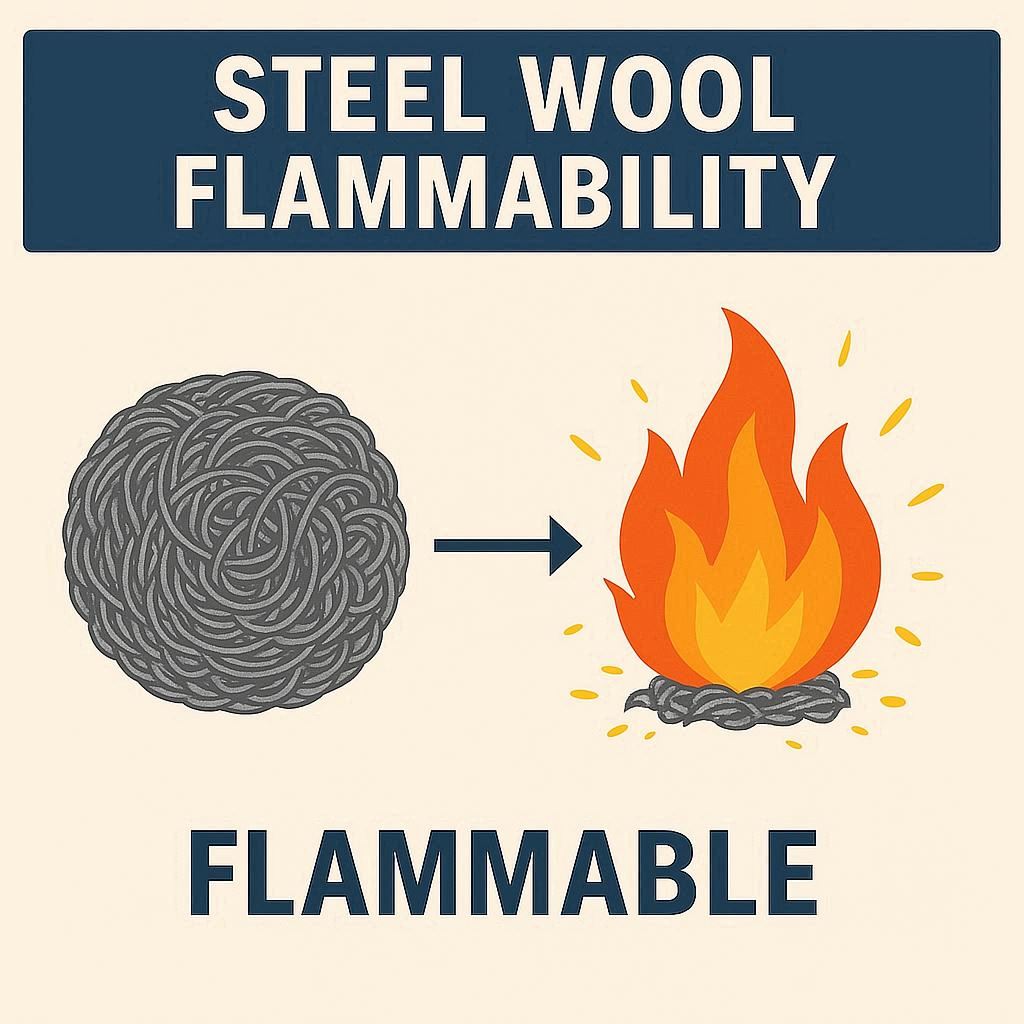
Steel wool is a common household item that many of us have in our cleaning supplies. But have you ever wondered if steel wool is flammable? In this article, I’ll delve into the truth behind whether steel wool can catch fire and the potential risks associated with it.
When it comes to fire safety at home, it’s essential to know the properties of the materials we use. Steel wool may seem harmless, but under certain conditions, it can indeed be flammable. Understanding how to handle steel wool safely is crucial to prevent any accidents or fires in your home.
Join me as I uncover the facts about the flammability of steel wool and provide you with valuable insights on how to use it responsibly. Let’s explore the truth behind whether steel wool is flammable and how you can stay safe while using this versatile household product.
Key Takeaways
- Steel wool can be flammable under specific conditions such as exposure to moisture, heat sources, oxidizing agents, and contaminants.
- Proper storage in a cool, dry place, disposal by soaking in water, and avoiding contact with accelerants are essential safety practices when using steel wool.
- Understanding the risks associated with flammable steel wool, including high combustibility, rapid ignition, fire spread, and toxic fumes, is crucial for safety.
- Safety precautions such as wearing protective gear, storing away from heat and moisture, and avoiding open flames are necessary when handling steel wool.
Exploring the Flammability of Steel Wool
When it comes to flammability, it’s crucial to understand how steel wool behaves in different situations. While steel wool itself may not ignite easily, it can catch fire under specific circumstances. Steel wool is primarily made of iron and carbon and can rust when exposed to moisture. This rusting process generates heat and can lead to combustion when in contact with flammable materials.
Steel wool’s flammability can also be influenced by its grade. Coarser grades have a higher chance of igniting compared to finer grades due to their increased surface area and exposure to oxygen. In addition, contaminants or residues on the steel wool, such as oils or cleaning chemicals, can increase its flammability.
To prevent accidental fires when using steel wool, it’s essential to store it properly in a cool, dry place away from heat sources. When disposing of used steel wool, ensure it is free from any flammable residues and consider soaking it in water before discarding it.
While steel wool is not highly flammable on its own, it can pose a fire risk if not handled with care. By being aware of its potential to ignite and taking precautions to minimize these risks, you can safely enjoy the benefits of steel wool in your household activities.
Conditions That Make Steel Wool Flammable
When it comes to understanding steel wool flammability, it’s essential to consider the specific conditions that can make it highly combustible. Here are some key factors to keep in mind:
- Moisture: Exposure to moisture can accelerate the rusting process of steel wool, making it more prone to ignition.
- Heat Sources: Proximity to heat sources such as open flames, sparks, or hot surfaces significantly increases the risk of steel wool catching fire.
- Oxidizing Agents: Contact with oxidizing agents can enhance the flammability of steel wool, leading to potential fire hazards.
- Contaminants: The presence of contaminants on steel wool, such as oils or greases, can act as accelerants, making it easier for the material to ignite.
By being aware of these critical conditions that can make steel wool flammable, individuals can take proactive measures to mitigate the risks associated with its use.
Risks Associated with Flammable Steel Wool
When it comes to flammable steel wool, it’s essential to be aware of the potential risks involved. Here are key points to consider:
- High Combustibility: Steel wool is highly combustible, especially in the presence of certain factors like moisture, heat sources, oxidizing agents, and contaminants.
- Rapid Ignition: Due to its fine, fibrous nature, steel wool can ignite quickly when exposed to a spark or flame.
- Intensified Fire Spread: Once ignited, steel wool can contribute to the rapid spread of fire, making it crucial to handle and store it properly.
- Toxic Fumes: Burning steel wool can release toxic fumes and smoke, posing health risks to individuals in the vicinity.
Given these risks, it’s vital to handle steel wool with caution and implement preventive measures to minimize the chances of a fire incident. By understanding the inherent risks associated with flammable steel wool, individuals can prioritize safety and take appropriate steps to mitigate potential hazards.
Safety Precautions for Handling Steel Wool
- **Store steel wool in a cool, dry place away from heat sources and moisture to prevent spontaneous combustion.
- **Never leave steel wool in contact with oxidizing agents or contaminants that could increase its flammability.
- **Dispose of used steel wool properly by soaking it in water before discarding it to ensure it is fully extinguished.
- **Wear gloves and eye protection when handling steel wool to avoid any potential injuries.
- **Avoid using steel wool near open flames or sparks to reduce the risk of accidental ignition.
Staying Safe While Using Steel Wool
When handling steel wool, it’s crucial to prioritize safety to avoid accidents and injuries. Here are some essential tips to keep in mind:
- Wear gloves and eye protection to protect your hands and eyes from any potential harm.
- Avoid using steel wool near open flames or sparks to minimize the risk of accidental ignition.
Implementing these safety measures is vital for minimizing the risks associated with steel wool.
Conclusion
Handling steel wool safely is essential to prevent accidents and injuries. Wearing gloves and eye protection is crucial when working with steel wool to avoid any harm. It is important to remember not to use steel wool near open flames or sparks to minimize the risk of accidental fires. By following these safety precautions, you can ensure safe and responsible usage of steel wool. Remember, safety always comes first when working with potentially flammable materials like steel wool.
Frequently Asked Questions
Is wearing gloves and eye protection necessary when handling steel wool?
Yes, wearing gloves and eye protection is vital when handling steel wool to prevent injuries. Gloves protect your hands from cuts and abrasions, while eye protection shields your eyes from potential damage caused by flying particles.
Why should I avoid using steel wool near open flames or sparks?
Avoiding the use of steel wool near open flames or sparks is crucial because steel wool is highly flammable. Any contact with sources of ignition can result in accidental fires, posing significant risks to your safety and surroundings.
How important are safety measures when using steel wool?
Safety measures when using steel wool are paramount to minimize the risk of injuries and accidents. By following safety protocols such as wearing protective gear and avoiding ignition sources, you can ensure safe handling and prevent potential harm.
